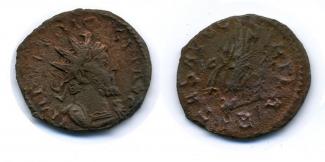'Antoninianus' of the emperor Tetricus I Roman, AD270-273
Found on an archaeological site at Frederick Place, Winchester, Hampshire
The antoninianus was introduced as a silver coin by the emperor Marcus Aurelius Antoninus, better known as Emperor Caracalla, in AD215 and was worth 1.5 denarii. By the time of Tetricus I the coins had become debased. This coin, struck at the mint at Trier, has perhaps just 2% silver compared with the 40% in the earlier antoniniani. By AD270 there was little else in general circulation but debased antoniniani. The inflation arising from debasement meant that large numbers of coins were required for purchases which led to widespread counterfeiting. Tetricus and his son of the same name were the last rulers of a break-away 'Gallic' empire set up in Gaul, Britain and Spain, with part of north Italy, in AD260. It fell to Aurelian in AD274.



